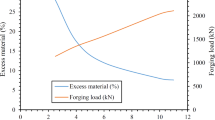Abstract
The body assembly process design (BAPD) system is currently under development at the laboratory of Auto Body Manufacture Technology Center of Shanghai Jiao Tong University. To ensure that assembly issues have been properly considered in the conceptual design phase, different methods, procedures and tools should be developed. The paper gives a brief view of the system architecture of the BAPD system, and the paper will present a framework to carry qualitative simulation procedure and conduct hierarchical qualitative simulation to analyze and predict assembly variation flow with limited parameters and fuzzy knowledge; the system conducts qualitative information acquisition of physical parameters of assembly features, and obtains cardinal factors influence the variation results by qualitative analysis in the assembly process. An analytical case is discussed to explain the function of qualitative analysis.
Similar content being viewed by others
References
Prisco U, Giorleo G (2002) Overview of current CAT systems. Integrated Comput Aided Eng 9(4):373–387
Shen Z (2003) Tolerance analysis with EDS/VisVSA. J Comput Inf Sci Eng 3:95–99
Schlatter B (1996) Computer-aided 3D tolerance analysis of disk drives. IBM J Res Develop 40(5):537–542
Boothroyd G, Dewhurst P (1991) Product design for assembly. Boothroyd Dewhurst Inc, Wakefield, RI, USA
Boothroyd G, Dewhurst P (1988) Product design for manufacture and assembly. Manuf Eng 111(1):42–46
de Mello H, Sanderson AC(1991) A correct and complete algorithm for the generation of mechanical assembly sequence. IEEE Trans Robot Automat 7(2):228–240
Zha XF, Lim SYE, Fok SC (1999) Development of expert system for concurrent product design and planning for assembly. Int J Adv Manuf Technol 15(3):153–162
Wang JF, Liu JH, Zhong YF (2005) A novel ant colony algorithm for assembly sequence planning. Int J Adv Manuf Technol 25(11–12):1137–1143
Zha XF, Lim SYE, Fok SC (1998) Integrated knowledge-based assembly sequence planning. Int J Adv Manuf Technol 14(1):50–64
Ong NS, Wong YC (1999) Automatic subassembly detection from a product model for disassembly sequence generation. Int J Adv Manuf Technol 15:425–431
Jin J, Shi J (1999) State space modeling of sheet metal assembly for dimensional control. ASME Trans, J Manuf Sci Technol 121(4):756–763
Huang Q, Shi J (2003) Simultaneous tolerance synthesis through variation propagation modeling of multistage manufacturing processes. NAMRI/SME Trans 31:515–522
Huang Q, Zhou N, Shi J (2000) Stream of variation modeling and diagnosis of multi-station machining processes. Proc. 2000 ASME International Mechanical Engineering Congress & Exposition, 5–10 Nov 2000, Orlando, FL 11:81–88
Chase KW, Parkinson AR(1991) A survey of research in the application of tolerance analysis to the design of mechanical assemblies. Res Eng Des 3:23–37
Jinsong G, Chase KW, Magleby SP (1995) Comparison of assembly tolerance analysis by the direct linearization and modified monte carlo simulation methods. Proc ASME Des Eng Tech Conferences Boston, MA 82(1):353–360
Hu M, Zhongqin L, Xinmin L(2001) Simulation and analysis of assembly processes considering compliant, non-ideal parts and tooling variations. Int J Mach Tool Manuf 41:2233–2243
Liu SC, Hu SJ (1998) Sheet metal joint configurations and their variation characteristics. J Manuf Sci Eng 120(5):461–467
Nikolaidis E, Long L, Ling Qb (2000) Neural networks and response surface polynomials for design of vehicle joints. Comput Struct 75:593–607
Lee B, Saitou K (2003) Assembly synthesis with subassembly partitioning for optimal in-process dimensional adjustability. Proc ASME Design Engineering Technical Conference 2 A:257–268
Forbus KD (1984) Qualitative process theory. Artif Intell 24:85–168
Kuipers B (1986) Qualitative simulation. Artif Intell 24:85–168
Coiera E (1992) The qualitative representation of physical systems, knowledge. Eng Rev 7.1
Adam DK, Grant E (1994) QMTool-a qualitative modeling and simulation CAD system for designing automated workcells. Proc 1994 IEEE International Conference on Robotics and Automation 2:1141−1146
Adam GK (2003) Qualitative simulation of discrete-event and continuous machine processes, Internet J Electron Lett [online http://www.electronicsletters.com/papers/2003/0018/ paper.asp,ISSN1213-
Bohanec M, Rajkovic V (1999) Multi-attribute decision modeling: Industrial applications of DEX. Informatica 23:487–491
Bohanec M, Zupan B, Rajkovic V (2000) Applications of qualitative multi-attribute decision models in health care. Int J Med Informatics 58–59:191–205
Author information
Authors and Affiliations
Corresponding author
Rights and permissions
About this article
Cite this article
Yubing, L., Guanlong, C., Xinming, L. et al. A framework of auto body assembly qualitative simulation system. Int J Adv Manuf Technol 33, 1244–1255 (2007). https://doi.org/10.1007/s00170-006-0554-y
Received:
Accepted:
Published:
Issue Date:
DOI: https://doi.org/10.1007/s00170-006-0554-y




